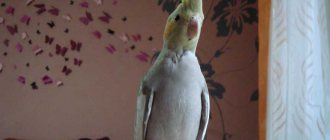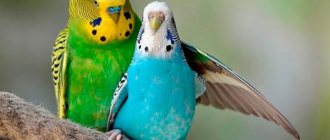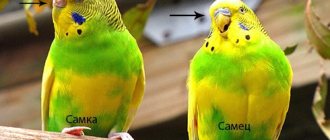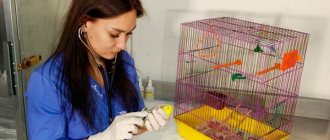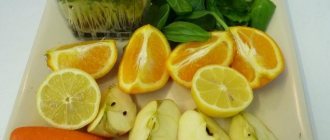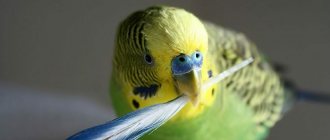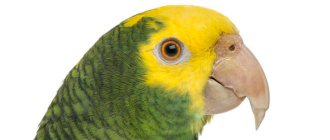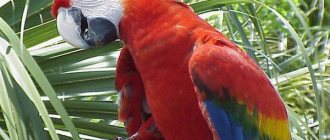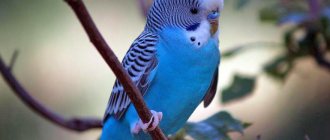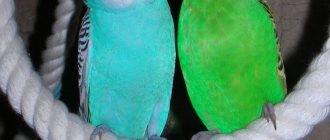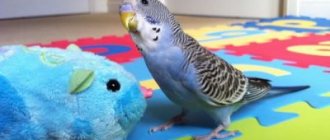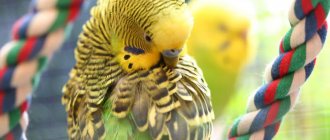Beginning of nesting
Evidence that the female will soon lay an egg is a subtle movement of the tail, commensurate with the bird's breathing rhythm.
8-14 days after the pair begins mating, the female parrot lays the first egg. Subsequently, the clutch will be replenished every 2-3 days if you have a small bird, and every 4-5 days if the bird is large.
Parrot eggs are oval in shape and matte white in color. Only the female incubates the eggs The male often flies to feed her, can stay in the nest for a long time, but does not take part in the incubation process.
The female may leave the nest for a long time, but this does not cause harm, since the eggs can safely tolerate slight cooling. The female leaves the nest mainly to empty her bowels. It is interesting to note that the female who incubates the eggs has a litter weight that is approximately 10% of her body weight.
The weight of excreted stool and the frequency of bowel movements return to normal at the end of the nesting season. The female periodically turns the eggs over and moves them from place to place; this process eliminates the fusion of the embryo and the egg shell, and also ensures uniform heating of the clutch (the temperature of the eggs lying inside the clutch and on the edge is very different). Typically, young birds have a smaller brood size compared to mature birds. Small bird species usually have 4-8 eggs in their clutch, while large ones have 2-4 eggs.
When are budgies ready to breed?
Puberty in males occurs at 10 months, in females - in the second year of life. Only those birds that like each other and get along are allowed for breeding. Under the influence of the sexual instinct, a couple in love looks very cute: the male constantly adjusts his beloved feathers, carefully covers her with his wing, shows off and coos. The gentleman takes care of the female for several days, and she tenderly accepts his affection.
The nesting house serves as an incentive for reproduction. The owner, expecting offspring from his charges, must take care of purchasing a nest in advance. Having discovered a new object, the female begins to intensively arrange the place for laying: she drags inside twigs, sawdust, paper - everything she finds around. Creating a cozy place takes all the energy from the expectant mother; she develops an excellent appetite.
Attention! During preparation for nesting, parrots need increased nutrition with a high calcium content. This element is necessary for the proper formation of eggs.
The finished family nest calms the female, she relaxes and gives her partner unambiguous signals. Mating occurs several times a day, and the entire process takes 1–2 weeks.
Hatching eggs
7-10 days after they are laid, you can find out whether they are fertilized or not. To do this, you need to bring the egg to a bright lamp and look into the light to see if there is a darkening in it with vascular mesh diverging to the sides or if the shell is empty. An unfertilized egg can be removed from the nest if the clutch is large enough (more than 5-6 fertilized eggs remain). This way the female will not waste energy. If the clutch is small, then it is best to leave empty eggs in the nest. The eggs, warmed by the female’s body, will give off their heat to the chick embryos developing in other eggs. You should not unnecessarily remove or touch parrot eggs from the clutch. But if they are heavily soiled, they can be washed carefully. They must be placed in warm water (35-40° C) and left there until the dirt dissolves. Then carefully wipe the eggs with gauze. If a slight superficial damage to the shell is detected, the crack should be sealed with a piece of plaster. However, it should be noted that when carrying out these manipulations, a thin layer of protein present on the shell is washed off. Because of this, the permeability of the eggshell increases, and in 50% of cases the development of the embryo stops.
Depending on the type of parrot, incubation of the clutch lasts approximately 17-35 days. All this time, the female warms the eggs to a temperature of at least 37°C, moisturizes them with her wet feathers (therefore, the opportunity to swim is necessary), this is reliable protection for the developing offspring. Having become sufficiently strong and matured inside the egg, the parrot chick begins to peck its way to freedom.
How to arrange an aviary?
An aviary is a very large cage that can occupy part of a room. When making aviaries for breeding budgies, you can use a variety of materials, in particular:
- Multilayer plywood;
- Plastic;
- Various types of meshes;
- Steel or duralumin corner.
It is not recommended to paint or cover the inside of the enclosure with paints that contain toxic substances. After all, parrots are very inquisitive, they “taste” everything around them and, having pecked on toxic substances, can die.
When planning to breed budgerigars in an aviary, it is also very important to choose the right strong metal mesh with the appropriate mesh size for its construction. Let us immediately note that a mesh made of copper and brass wire is not suitable, since the surface of such wire is covered with oxides, which can cause severe poisoning of birds.
The most suitable option may be a fur farming mesh with cells 16 x 48 mm:
Let us immediately note that a mesh made of copper and brass wire is not suitable, since the surface of such wire is covered with oxides, which can cause severe poisoning of birds. The most suitable option may be a fur farming mesh with cells 16 x 48 mm:
- It can be easily and securely attached to any (wooden or metal) frame;
- If any individual cell is damaged, it does not lose strength.
As for painting the mesh, there are also certain requirements:
- You need to paint evenly, in a very thin layer, avoiding smudges (this will prevent birds from pecking at the paint);
- Paint only black (this will make it easier to watch the birds);
- For metal surfaces, use nitro paint;
- After painting, the mesh should dry well (then the paint will adhere tightly and will not crumble under the beak).
There is one more important detail - if the frame of the enclosure is planned to be made from wooden beams, then the mesh must be fastened from the inside, and the corners of the beams accessible to the beaks of the parrots must be protected with steel corners.
For ease of cleaning, enclosures should be provided with trays, which are best made from materials that cannot corrode under prolonged exposure to moisture. It could be:
- Roofing galvanized iron;
- Sheet duralumin.
Also, when setting up an enclosure, you need to remember that food waste, which will constantly remain after feeding, can attract small rodents (mice, rats). Therefore, everything must be done to prevent them from getting inside the enclosure. After all, they can:
- Cause dangerous infections;
- Contaminate and destroy food, rendering it unsuitable for birds to eat;
- Cause panic in the flock, as a result of which the birds may be injured and even die;
- Attack birds sitting on the floor, destroy young animals.
The best way to protect against such “guests” is to cover the floor and walls with sheet iron, especially paying attention to the baseboards and corners
Important! In order for parrots of different generations to coexist in the aviary, it can be divided into two parts. One of them will house couples who are expecting offspring, the other will house young animals.
And it is most convenient to keep birds prepared for sale in cages arranged in tiers. But this is not all the secrets of breeding budgies.
One of them will house couples who are expecting offspring, the other will house young animals. And it is most convenient to keep birds prepared for sale in cages arranged in tiers. But this is not all the secrets of breeding budgies.
Important! In order for parrots of different generations to coexist in the aviary, it can be divided into two parts. One of them will house couples who are expecting offspring, the other will house young animals.
And it is most convenient to keep birds prepared for sale in cages arranged in tiers. But this is not all the secrets of breeding budgies.
The female eats her eggs
It happens that females eat their own laid eggs.
Such an anomaly in the behavior of parrots is rare; it is usually caused by a lack of calcium in the bird’s body.
Check that the cage contains mineral feed containing this element.
In any case, do not remove the nesting box; after eating a few eggs, the young female can “correct” and become an excellent hen in the future.
Signs of complications
Eggs do not always appear according to the usual scenario. Problems with egg laying occur due to improper nutrition: the shell acquires an abnormal structure. During pregnancy, the female parrot needs to be observed in order to notice difficulties in time and provide assistance.
A young female does not immediately understand how to behave during childbirth. Sometimes her efforts are in vain - the egg gets stuck in the cloaca. The bird breathes hard, strains, but cannot cope. If you don’t help her urgently, the egg in the birth canal will put pressure on other organs and nerves. This often leads to death.
Attention! If the egg does not come out for a long time, the female is forced to sit in an uncomfortable position. Numbness of the paws and limping are also complications.
Causes of death of fetuses
There are cases when embryos die during the development of the egg.
If such cases are isolated, then there is no need to worry. If embryos die often, then most likely this is due to genetic reasons.
Most likely, at the moment of fertilization, genes were combined in such a way that they created a factor leading to the death of the embryo.
It happens that a fully formed chick dies in the egg. Parrot breeding experts suggest several possible reasons for this phenomenon:
- the embryo is infected with pathogens;
- eggs are not sufficiently supplied with nutrients;
- embryos die as a result of closely related mating (inbreeding);
- toxic substances have entered the water or feed.
What factors provoke egg production?
In the wild, cockatiels usually breed in spring and summer. This is due to a number of factors that stimulate sexual behavior in birds. Domesticated birds are affected by several other external stimuli that can cause egg production in the pet.
Provoking factors for egg laying
- Rich diet . An abundance of protein and fatty foods can provoke sexual behavior in birds. After all, these substances are primarily necessary for the formation of eggs and the growth of chicks. Products rich in these components include sunflower seeds, nuts, oilseeds, and animal feed. A varied diet and the presence of various tasty treats in large quantities also contribute to a favorable time for reproduction.
- Increasing daylight hours . In nature, the nesting period is a seasonal phenomenon. From the beginning of March, daylight hours become longer, which is a signal for birds to reproduce. At home, it can be increased thanks to artificial lighting, a TV or computer running in the evening.
- Ambient temperature. A warm, humid climate also signals the beginning of the mating season.
- Presence of neighboring birds. When kept together with other birds, the cockatiel may also begin to lay eggs. The incentive for this is the presence of a female sitting on the nest or an individual demonstrating mating behavior.
- Toys or mirror. In the absence of a partner, the cockatiel may mistake an object or its own reflection for it.
- Affectionate treatment of a person. By showing his love for the parrot in the form of stroking the plumage, the owner can provoke a desire in the bird to lay an egg. This is because these actions are similar to courtship among birds. If you finger the feathers on your pet’s head, stroke it on the back and under the wings, then the person’s hand can be regarded as a sexual partner.
Affectionate treatment of a person is perceived as a partner - Pet's emotional state. If your bird lays eggs, it means she feels completely safe and enjoys life. In conditions of constant stress, illness and lack of attention, the parrot is unlikely to think about procreation.
Problems with unfertilized eggs
There are cases when the entire clutch consists of unfertilized eggs, more often this happens in pairs that nest for the first time. In such a situation, you should not remove the eggs from the nest. It is necessary to give the female the opportunity to sit on the eggs for the required period and only then remove them. After this, the bird will begin to rush again. The couple maintains a reproductive rhythm, and most likely the eggs in the next clutch will be fertilized. The reasons for this phenomenon and ways to solve them:
- the cloaca area was covered with long plumage, and this prevented mating. To solve this problem, it is advisable to pluck the parrot’s feathers in the cloaca area;
- The perches in the cage are not firmly fixed. The female must be firmly held on the perches, so they should be designed differently;
- The manufacturers' food was insufficiently fortified and nutritious. For favorable reproduction of parrots, it is necessary to include minerals, vitamins and protein food in the diet;
- the pair did not rest after the previous nesting season. For fruitful mating, it is advisable to mate birds no more than 2 times in a row. After 2 nesting seasons, the birds should be allowed to rest for at least six months;
- the temperature in the breeding room was below 15 °C. To solve this problem, increase the temperature in the room where the parrots are kept.
Basic moments
It is best to select a young pair of birds for hatching chicks. Before preparing the birds’ house and other conditions for nesting, you should make sure they like it. The birds should coo in unison; if the male cleans the female’s feathers and kisses her on the beak, then we can say that the couple is ready. Owners should be alerted to behavior when the wavy ones do not contact, hiss at each other and hide in fear at the other end of the cage.
The most suitable and favorable age for a bird to lay eggs is at least 1 year. Some wavy birds begin to lay eggs at 8-9 months, which can be dangerous for their health, because at this age the female is not yet strong enough to bear offspring. When a couple has formed, you should not try to separate it and place a new female with the male, since such changes will negatively affect the condition of the birds.
The best period for breeding is considered to be spring and summer. A large abundance of light, warmth, vitamins and greenery at these times of the year have a beneficial effect on the well-being and mood of birds. It is not uncommon for wavy birds to start laying eggs in winter.
In case of such a phenomenon, it is important to create all the conditions for comfortable hatching of the offspring and make sure that the bird consumes a sufficient amount of vitamins
"Attention! A month before mating, it is important to prepare the female in advance. The bird's house must be constantly open so that they can fly calmly and strengthen their muscles. The cage must always have fresh food and water.
It is important to provide budgies with herbs, fruits and vegetables, chalk and mineral stones. It also does not provide the bird with complementary foods in the form of cottage cheese and sprouted grains.”
The cage must always have fresh food and water.
It is important to provide budgies with herbs, fruits and vegetables, chalk and mineral stones. It also does not provide the bird with complementary foods in the form of cottage cheese and sprouted grains.”
Preparing a nest for lovebirds
It is not at all enough to simply put the female and male in a separate cage and wait for offspring. To do this, they need to arrange a special place. This can be a wooden nest similar to a birdhouse, only for lovebirds. Or maybe a hollow is a part of a tree trunk, inside of which a depression is made. Make sure there is enough space for both eggs and future parents.
Some people place a small plywood box in a cage as a nest for lovebirds, keeping the following dimensions - bottom 25x15 cm, height 20 cm. You also need to make a recess for the masonry there. What can you put in the nest? Place small tree branches there, pre-treated with boiling water, later the female will build a nest from them. And don’t forget about access to the nest for regular cleaning and disinfection. By the way, before placing the nest in the cage it must be treated with disinfectants.
It is important that the nest is not permanently in the cage; it should be placed there only in summer or autumn, that is, when you want to get offspring from parrots. After the chicks become independent, the nest is removed so that the lovebirds do not breed again
Otherwise, frequent reproduction can lead to serious depletion of the body, and the offspring are quite weak.
